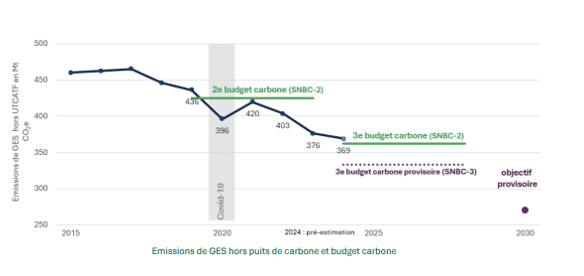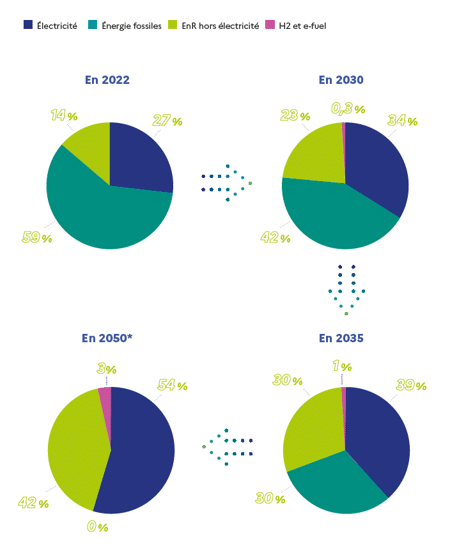An energy mix with more ENR, what part of renewable? What goal of energy sobriety? The Pluriannual Energy Programming Law must answer its strategic questions, but the government has still not decided. Decryption!
Reminder of decarbonization issues
The national low carbon 3 strategy
The national low carbon strategy (SNBC) is the French roadmap towards carbon neutrality by 2050.
It dates from the law of 2015 and constitutes the framework of action of France in matters of attenuation of climate change.
This strategy includes:
- A long -term objective, carbon neutrality in 2050 with reductions in greenhouse gas emissions (GHG) in all sectors of activity (transport, agriculture, building, industry, etc.).
- Greenhouse gas emission ceilings not to be exceeded by 5 -year periods, so -called carbon budgets.
The law provides for the revision of the SNBC every five years.
The SNBC 2, still in force, was adopted by decree in April 2020.
Version 3, still awaiting publication by the government, enhances the objectives of France by being part of those of the European Union (Legislative Package "Fit for 55"):
- reduction of EU emissions by 55% in 2030 compared to 1990
- Or a reduction for France by 5 % each year on average between 2022 and 2030, compared to 2 % annual reduction on average from 2017 to 2022.
After a decrease of 5.8% in 2023, the pace slowed according to the last Citepa : -1.8% only in 2024 (figures still provisional).

Focus on the construction sector
The sector, residential and tertiary included, constitutes a strategic sector: the most energy -consuming with 44% of French final energy consumption.
The objective for this sector in SNBC is to drastically reduce its GHG emissions by 95% by 2050. Where are we? According to the latest CITEPA figures, the sector has reached its lowest level of emission in 2024 since 1990 (57mt CO2E) but it stagnates: -0.7% on 2024 compared to 2023!
Advanced reasons: a drop in the number of energy renovations & a low increase in energy prices limiting the price signal.
In the tertiary sector, the regulations however be strengthened with the entry into force since January of the 1st deadline of the Bacs decree and the publication this year of the first notes Éco Energie tertiary on the Operat platform of Ademe.
What energy mix in 2030 and 2050?
The SNBC and its GHG reduction objectives constitute the consumption component of France's energy policy. The production of the energy mix production depends on the Multi -year Energy Programming Law (PPE) delayed by the current political context
2 years late for the PPE
Created by the law of August 17, 2015 relating to the energy transition for green growth, multi -year energy programming (PPE) is a strategic piloting tool for France's energy policy.
Each PPE covers two successive periods of five years. This third PPE is established for the period 2025-2035. Like the previous ones, it will be reviewed mid-term, in 2030.
The PPE 3 plans to strongly decarbonize our economy: to switch to 2022 from 60% fossil fuels in our energy mix to 0% by 2050.

Macro objectives that hide the crucial detail of the energy mix: what part of renewable? nuclear? What goal of energy sobriety?
The debate is lively among parliamentarians: the Senator LR Daniel Gremillet had tabled a bill "relating to national programming and normative simplification in the economic sector of energy". Adopted in the Senate, she aspired to clarify the energy mix:
- 560 TWh of decarbonized electricity by 2030, including at least 200twh from renewable sources
- 27 GW of new nuclear capacity installed by 2050 with 14 new EPR2 & 15 SMR (Small reactors)
But in the National Assembly, the bill was unraveled, in particular by an amendment voted by the right and the extreme right: it established a moratorium on any new wind or solar project! A text finally rejected by a large majority on June 24.
The government, for its part, prefers to go through a decree, "by the start of the school year", according to the recent declarations of the Minister of Industry and Energy. So 2 years late.
Consume less and especially consume better
One certainty: the PPE 3 will act the electrification of the uses encouraged by the regulations:
- Decarbonated heating with heat pumps
- Electric vehicle development
- Decarbonation of very intensive energy industries
The challenge for the future is therefore to consume less fossil energy and above all better electricity to ensure the balance of the network. The development of photovoltaics in roof (APER law of 2023) and vehicle recharge terminals (LOM law) offer strategic synergies to flexible our electrical uses.
Flexibility is the capacity of a building to modulate its demand and its production of energy according to the peaks of requests on the network (and therefore to avoid peak hours). There are three levers to activate:
- erase
- gap
- modulation
And this on several uses such as non -critical lighting, ventilation, heating/air conditioning, IRVE (charging infrastructure for electric vehicles), or certain office or industrial equipment.
This study is based on the analysis of consumption data, via the GTB or sensors, and on modeling of the potential for offseting uses. Objective: Build a coherent management strategy to maximize self -consumption.
